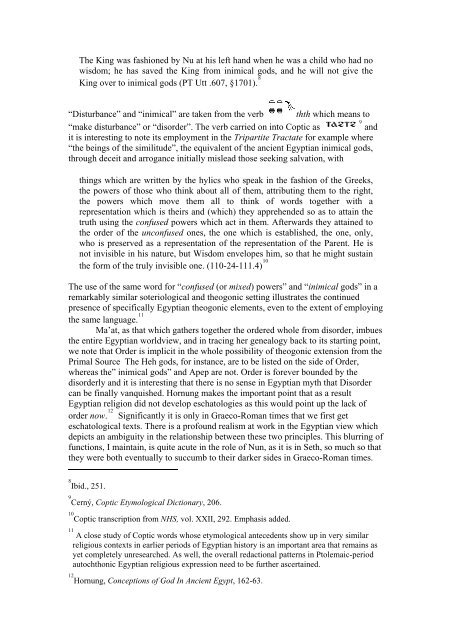THE EGYPTIAN FOUNDATIONS OF GNOSTIC THOUGHT
THE EGYPTIAN FOUNDATIONS OF GNOSTIC THOUGHT
THE EGYPTIAN FOUNDATIONS OF GNOSTIC THOUGHT
You also want an ePaper? Increase the reach of your titles
YUMPU automatically turns print PDFs into web optimized ePapers that Google loves.
The King was fashioned by Nu at his left hand when he was a child who had no<br />
wisdom; he has saved the King from inimical gods, and he will not give the<br />
King over to inimical gods (PT Utt .607, §1701). 8<br />
“Disturbance” and “inimical” are taken from the verb thth which means to<br />
9<br />
“make disturbance” or “disorder”. The verb carried on into Coptic as and<br />
it is interesting to note its employment in the Tripartite Tractate for example where<br />
“the beings of the similitude”, the equivalent of the ancient Egyptian inimical gods,<br />
through deceit and arrogance initially mislead those seeking salvation, with<br />
things which are written by the hylics who speak in the fashion of the Greeks,<br />
the powers of those who think about all of them, attributing them to the right,<br />
the powers which move them all to think of words together with a<br />
representation which is theirs and (which) they apprehended so as to attain the<br />
truth using the confused powers which act in them. Afterwards they attained to<br />
the order of the unconfused ones, the one which is established, the one, only,<br />
who is preserved as a representation of the representation of the Parent. He is<br />
not invisible in his nature, but Wisdom envelopes him, so that he might sustain<br />
the form of the truly invisible one. (110-24-111.4) 10<br />
The use of the same word for “confused (or mixed) powers” and “inimical gods” in a<br />
remarkably similar soteriological and theogonic setting illustrates the continued<br />
presence of specifically Egyptian theogonic elements, even to the extent of employing<br />
the same language. 11<br />
Ma’at, as that which gathers together the ordered whole from disorder, imbues<br />
the entire Egyptian worldview, and in tracing her genealogy back to its starting point,<br />
we note that Order is implicit in the whole possibility of theogonic extension from the<br />
Primal Source The Heh gods, for instance, are to be listed on the side of Order,<br />
whereas the” inimical gods” and Apep are not. Order is forever bounded by the<br />
disorderly and it is interesting that there is no sense in Egyptian myth that Disorder<br />
can be finally vanquished. Hornung makes the important point that as a result<br />
Egyptian religion did not develop eschatologies as this would point up the lack of<br />
order now. 12<br />
Significantly it is only in Graeco-Roman times that we first get<br />
eschatological texts. There is a profound realism at work in the Egyptian view which<br />
depicts an ambiguity in the relationship between these two principles. This blurring of<br />
functions, I maintain, is quite acute in the role of Nun, as it is in Seth, so much so that<br />
they were both eventually to succumb to their darker sides in Graeco-Roman times.<br />
8<br />
Ibid., 251.<br />
9<br />
Cerný, Coptic Etymological Dictionary, 206.<br />
10<br />
Coptic transcription from NHS, vol. XXII, 292. Emphasis added.<br />
11<br />
A close study of Coptic words whose etymological antecedents show up in very similar<br />
religious contexts in earlier periods of Egyptian history is an important area that remains as<br />
yet completely unresearched. As well, the overall redactional patterns in Ptolemaic-period<br />
autochthonic Egyptian religious expression need to be further ascertained.<br />
12<br />
Hornung, Conceptions of God In Ancient Egypt, 162-63.










